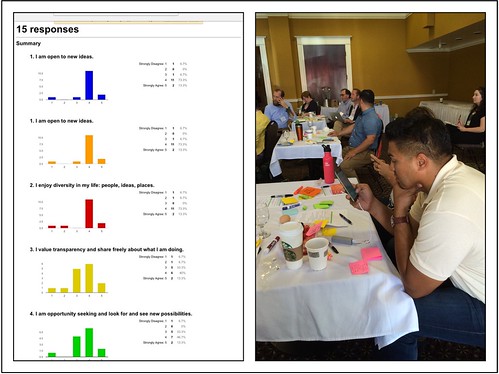Last week, in addition to giving the ending keynote and facilitating a design lab for the Arts Brain Trust at the National Arts Marketing Project Conference, I was a participant in a pre conference convening expertly facilitated by Jennifer Edwards who is an organizational development consultant, dancer, and teacher. As a trainer, it is always great to experience someone else facilitating so you can have empathy for participants, get some new ideas or reflect on your trade craft.
Here’s what my reflection:
Technology Tools To Poll Participants
Using online polling apps to query audiences and share aggregate results in real-time can be a useful tool to add to workshops, webinars, and conference sessions. Jennifer made use of an app called “Answer Qwik” that allows participants to answer polling questions on their mobile phones and have the aggregate results shown on the screen. (see above) It is designed to be used in face-to-face workshops and conferences. It does close-ended questions and displays a bar chart or can also create a word cloud.
When thinking about adding mobile/online polling to a training, you have to think like an instructional designer for it be effective. You have to ask, how is polling the audience and seeing the aggregate results helping people learn? In other words, to what end? Here how collecting data and displaying aggregate might enhance learning: (Add in the comments if you think I missed anything)
- Help the facilitator understand who is the room at the beginning (demographics, experience, attitudes, knowledge about the topic) – a quick and dirty participant assessment
- Support a fun icebreaker
- Help the facilitator understand how people are feeling half-way through the session so real-time tweaks to design can be made
- Help participants unpack a lot of potential topics to address
- Help the participants narrow down topics to discuss or work in small group exercises (replaces sticky dot voting and visualize the vote technique)
- Help participants vote on concepts or reports as part of a report out to stimulate discussion or reflection (replaces sticky dot voting and visualize the vote technique)
- Help participants self-assess their skills or attitudes by seeing aggregate data on the screen together and have it be catalyst for reflection
- Help participants digest and reflect on some content shared during the session
- Help participants evaluate the session in real-time – replacing the use of a flip chart in a plus/delta analysis

I have used online polling mostly on Webinars to learn more about audience characteristics at the beginning of the session and as reflection exercises in between sections of content. Several years ago at the Innogive Conference I used an audience polling app for a keynote panel that also enabled us to gather questions from the question to infuse into the discussion. This summer I was lucky enough to do a network training with June Holley. She had a network leadership assessment that asks participants to agree or disagree with statements related to network leadership qualities. Participants took the assessment and we saw the aggregate results. June facilitated a discussion about the network leadership qualities of the group. It was great fodder for a reflective discussion.
Incorporating Movement Into Icebreakers and Small Group Exercises
I feel strongly that to keep audiences engaged, they have to be moving. Research shows that movement is the killer app for learning. As a facilitator, you have to watch the participants body language and look for the “slump,” when they get tired and interject movement. I was very curious to see how Jennifer, who is a dancer, would incorporate movement into the convening.
She did so in the first few minutes. I’m always on the lookout for good icebreakers that don’t suck and was delighted with her movement icebreaker, although it might might work best with artist or activist audiences. It was before we did anything else. She had the 30 participants walk around the room while she urged us to open up and think about what we wanted to get out of the day. While walking around the room, she said, “Stop” and meet up with someone. Pause look into their eyes and say hello. And then had us continue to move. We did a few more stop and look and greet and then she has settle down into our chairs.
At the end of the day, as part of a reflection exercise, she had do a walk and talk with another person to discuss what we learned and what we hoped to apply.
What I Was Inspired To Adapt
I was inspired so I decided to alter one of the exercises in the design lab I facilitated two days later. Instead having people sit and interview each other, I had them write down the interview questions on 3×5 card and go for 20 minute walk around the hotel and do a walking interview, ten minutes teach. I told them to come back at a precise time.
There is that moment of fear, as the instructor, when you let go of control and trust your participants. As I waited in the empty room, I wondered how many would come back and how many would come back on time? They all arrived precisely on the dot! We even discussed how they could incorporate one-on-one check-ins as walking meetings.
What are some ways that you have incorporated movement or polling technology into your training or meeting?
